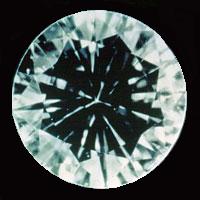Flat Cut Diamond: What It Is and How It Affects Appearance
A flat cut diamond refers to a diamond that has a shallower cut, where the crown (the upper portion of the diamond) is flat or only slightly angled, and the pavilion (the lower portion of the diamond) may also be less pointed. The flat cut style can influence the diamond’s overall brilliance, sparkle, and appearance.
Characteristics of a Flat Cut Diamond
Shallow Cut:
A flat cut diamond has a shallower depth compared to standard diamonds, which can cause light to enter and exit the stone in a way that doesn’t maximize brilliance and sparkle.
The crown is typically less angled, and the table (the top surface) may be larger relative to the depth of the diamond.
Shape:
Flat cut diamonds are usually found in antique or vintage-style diamonds, particularly in shapes like the Old Mine Cut or Rose Cut.
The facets may be fewer, and the depth of the diamond is minimized to create a more flat appearance.
Lack of Fire:
The shallower depth and flat angles may cause the diamond to have less fire (the dispersion of light into different colors), which is often seen in diamonds with deeper cuts like the Round Brilliant.
How the Flat Cut Affects the Diamond’s Appearance
Less Brilliance and Sparkle:
Due to the shallow cut, light may not reflect as effectively inside the diamond, leading to reduced brilliance (the white light reflections).
The sparkle may appear less intense compared to diamonds with deeper cuts, such as the Round Brilliant or Princess Cut, which are designed to reflect light more efficiently.
Larger Table:
Flat cut diamonds often feature a larger table (the top facet), which gives the diamond a broader appearance, but may also make the diamond appear less dynamic or lively compared to a well-cut diamond that exhibits more movement of light.
Antique or Vintage Look:
The flat cut is often chosen for antique or vintage-style jewelry, as it provides a distinctive look that differs from modern diamonds. The flat cut is associated with romantic and historical styles, and can lend a rustic or classic charm to pieces.
More Visible Inclusions:
Due to the shallower depth, inclusions or imperfections may be more visible on a flat cut diamond, especially if the diamond is not of very high clarity. A flat cut diamond may also appear less clean due to this.
How Flat Cut Diamonds Are Used
Vintage Jewelry: Flat cut diamonds are often used in antique-style engagement rings or vintage jewellery due to their historical appeal.
Rose Cut Diamonds: One of the most common types of flat-cut diamonds is the Rose Cut, which features a flat base and a domed, faceted top. The Rose Cut is prized for its vintage charm and subtle brilliance.
Pros and Cons of a Flat Cut Diamond
Pros:
Unique, Antique Look: Ideal for those who want a distinctive, vintage style.
Larger Table: A flat cut often appears larger, giving the diamond a wider visual presence.
Classic Appeal: Perfect for vintage-inspired designs or antique jewellery.
Cons:
Reduced Brilliance: Less sparkle and brilliance compared to modern diamonds with deeper cuts.
More Visible Inclusions: Inclusions may be easier to see due to the shallow depth.
Lower Fire: Less dispersion of color, meaning fewer flashes of light.
Flat Cut Diamonds
A flat cut diamond offers a unique, vintage look with its shallower depth and broader table. While it lacks the brilliance and fire of modern diamonds with deeper cuts, it is highly desirable for its antique charm and is often used in vintage-style or classic jewellery. If you’re looking for a diamond with a more traditional appearance or distinctive style, a flat cut might be the perfect choice, but it’s important to understand the trade-offs in light performance.
Would you like to explore more about vintage diamonds or specific diamond cuts?
